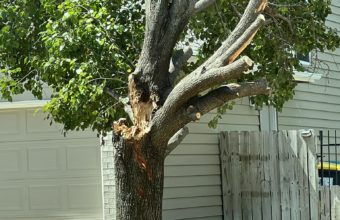The decision to cut lower branches off a tree, known as pruning or limb removal, depends on several factors and should be made carefully and with consideration for the tree’s health and your specific goals.
Here are some reasons why you might consider cutting lower branches off a tree and when it may be appropriate…
- Safety – Low-hanging branches can pose safety hazards, especially if they obstruct walkways, driveways, or visibility for drivers and pedestrians. Removing these branches can enhance safety.
- Clearance – Lower branches may interfere with structures, buildings, utility lines, or vehicles. Pruning can provide clearance for these objects and prevent potential damage.
- Aesthetics – Trimming lower branches can improve the overall appearance of a tree and enhance its visual appeal in your landscape.
- Light and Airflow – Removing lower branches can increase sunlight penetration to the ground and improve air circulation within the tree’s canopy. This can benefit both the tree and the surrounding landscape.
- Encouraging Growth – Pruning lower branches can direct the tree’s energy toward upper branches and encourage vertical growth, which may be desirable for certain tree species or for a specific aesthetic effect.
Keep the following considerations in mind…
- Prune Responsibly – When cutting lower branches, follow proper pruning techniques and avoid removing more than 25% of the tree’s canopy in a single growing season to minimize stress on the tree.
- Avoid Topping – Topping, which involves indiscriminate cutting of the upper branches or crown, should be avoided. Topping is a harmful and detrimental pruning practice that can severely damage a tree’s health and structure.
- Consider the Tree’s Health – Evaluate the overall health of the tree before pruning. Sick or stressed trees may not be suitable candidates for extensive limb removal.
- Species-Specific Pruning – Different tree species have different tolerance levels for pruning. Consult with a certified arborist or tree care professional to determine the appropriate pruning approach for your specific tree species.
- Observe Local Regulations – Be aware of any local regulations or permits required for tree pruning, especially if the tree is in a protected area or if it is considered a significant tree.
Pruning should be done with care and consideration for the tree’s well-being. If you are unsure about whether to cut lower branches off a tree or how to proceed, it’s advisable to consult with a certified arborist or tree care professional. They can assess the tree, discuss your goals, and provide expert guidance to ensure that the pruning is performed in a responsible and beneficial manner for both the tree and your landscape.






